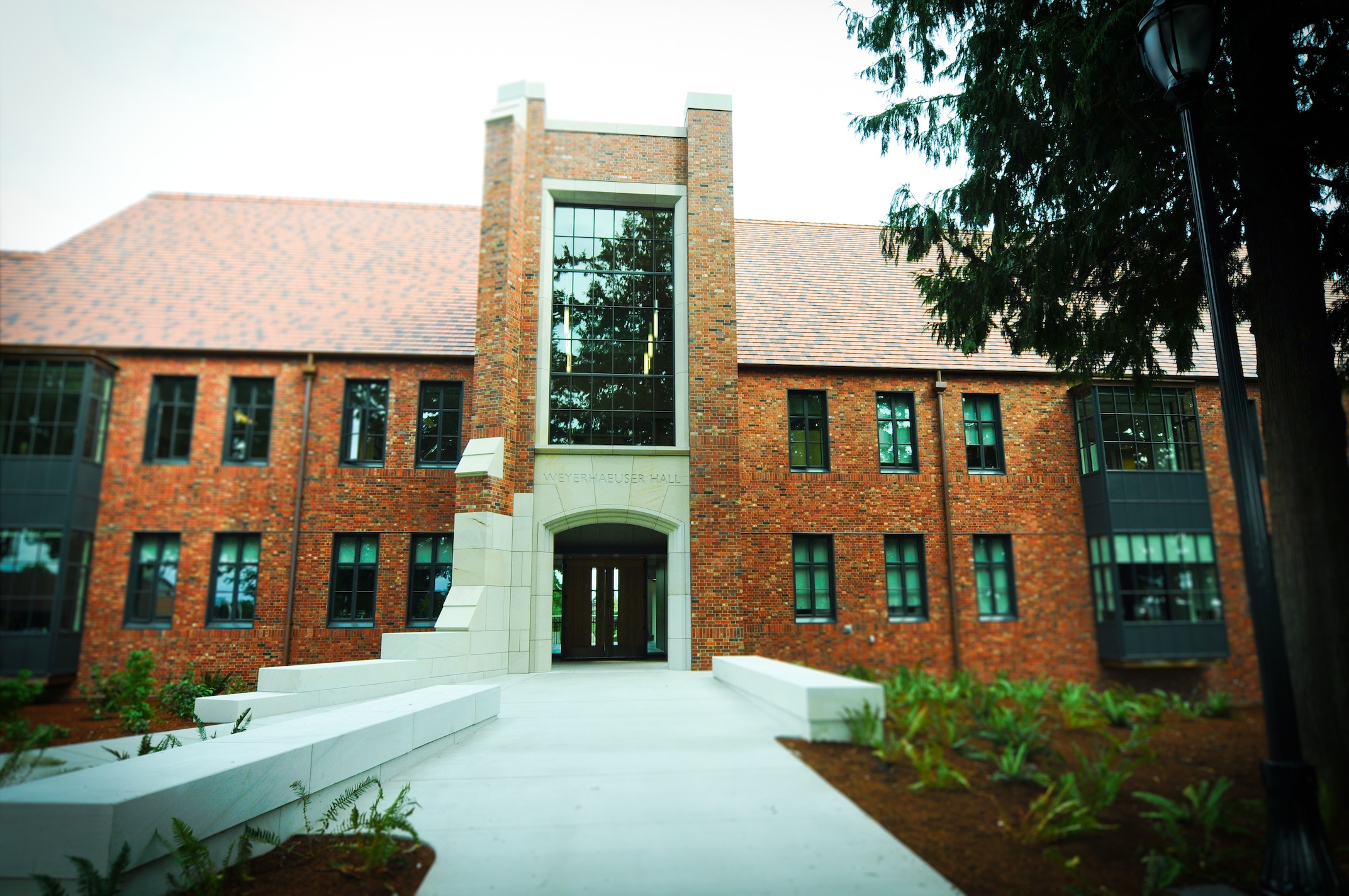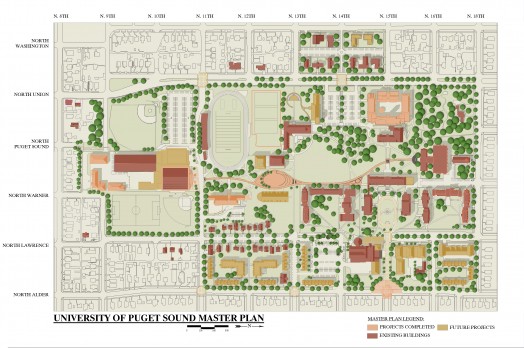
After a long, hot summer full of adventure, one of the greatest joys of returning to campus is to discover what changes have sprung up in the students’ absence. Last year the student body was enamored with the renovations that had occurred in the Anderson-Langdon Residence Hall, leaving its recent alumni harmlessly bitter at missing out and newer residences elated. This years changes are a far cry from the subtle facelift of a familiar campus facility, and instead Puget Sound students have returned to a complete rejuvenation of our University’s image. It is impossible to traverse campus this fall without being confronted with some aspect of the impressive changes completed this summer.
The new Center for Health Sciences is the clear centerpiece of this summer’s renovations. Completed within a year of ground breaking, the Center is a tremendous improvement for the campus. With this new facility, the classes, students and faculty of the Psychology, Exercise Science, Occupational Therapy and Physical Therapy Departments have been relocated from their former homes all over campus and brought together under one roof to help facilitate their interconnected nature.
The steering committee for the Center brought together a diverse collection of members from the Puget Sound community that included consultants from each of the departments involved. The committee went to tremendous lengths to ensure that the building’s design was consistent with the campus as a whole and would not disturb the natural beauty of the university.
Associate Vice President of Facilities Services Bob Kief, a member of the Center for Health Sciences steering committee, is tremendously proud of all the hard work that went into the Center, especially the effort to make sure Weyerhaeuser Hall is “the right building” for our campus.
Kief stressed the incredible detail put into the plan, which involved maintaining the architectural feel of campus and included the decision to move the footprint of the building back 20 feet to preserve the existing natural environment. The building, he said, serves not only as a wonderful resource for the four departments, but also as a physical presence on campus that benefits the whole community by tying together the north and south ends of the university.
As the community begins to embrace the new addition, Facilities and the steering committee are working hard to incorporate small changes suggested by the faculty to further improve the space as they continue to make it their own. One of the issues that has arisen that has not been as easily rectified is the overwhelming demand for space by the four departments. As a result, some classes like PSYC 301 (Experimental Methodology and Applied Statistics II) are still overflowing into Wyatt Hall. The building has also left some students on campus whose fields of study are outside of the four departments feeling a little slighted by the university and the Master Plan.
“It’s good that the psych department has a place, but it doesn’t mean much to me as someone who will never take a psych [class]. There are other departments that needed the space too,” junior Kelly Engle said.
Overall, the new Center for Health Sciences has been met with wonderful support from the campus community.
“The building is amazing. It’s absolutely wonderful and a huge improvement on the basements and portables we were in before,” Psychology and English major Rachel Soderstrom said.
When asked about his overall feelings regarding the work done this summer, Kief said, “People always say when we finish a project, that it’s always been there—that’s a compliment.”
The changes made to Collins Memorial Library are the perfect embodiment of that goal. This summer has found the library with a brand new entrance, increasing both accessibility to the library and the general aesthetic of the northern side of Karlen Quad. The theme of increased accessibility continues inside with the addition of elevator access to all five levels of the library, including the third and forth floors that were previously only accessible by stairs.
The addition serves to resolve “some of the less visible accessibility issues,” Kim Bobby, Clinical Associate Professor of Education and Chief Diversity Officer here at the University said.
Library Director Jane Carlin added that the new elevator also “improves day to day operations, [and] provides ease of access for our users.”
Overall, the campus community, much of which has noticed that the new renovations include the removal of minor study areas, has found the physical renovations to the library to be all for the better.
Also included in the changes this summer were some more minor renovations to help the overall aesthetic of the campus, including alterations to the Wheelock Information Center, which “wasn’t as friendly a look,” Kief noted.
“This [new] one is more within the setting, opening up room for people to use the space better,” Kief said.
Other changes included increasing practice space in Schneebeck, adding workout space to the fitness center and increasing campus infrastructure and safety. Kief said that a goal in the renovations was to create a more friendly, more united campus that would welcome the whole university community.
One of the ways this was achieved was the construction of the Commencement Walk. One of the most visible changes on campus since last spring, the granite walkway that spans from one side of campus to the other has attracted quite a bit of attention from the campus community. The addition has become a new center for socialization, encouraging members of the community to explore the campus.
“Even my own colleagues [can be seen outside on campus more], I meet them out there daily,” Kief said. Over the past few weeks students have embraced the Walk as an easier path to get from one side of campus to the other while faculty members and their families can be seen enjoying the last few days of Indian summer by walking around the new additions to campus.
In addition to being an impressive sight, the Walk also features some more functional benefits for campus. Along the theme of accessibility, Bobby noted, “The granite walk is gently sloping, and includes areas for rest, and that’s really important.
“These little things don’t interrupt the aesthetics on campus, but are really important for someone that needs to access that kind of support.”
The Walk will also serve to improve of the puddling of water on campus pathways during heavy rain, yet another small detail we may not fully appreciate in our every day rush around campus.
As was laid out in the 2023 Master Plan, the Walk embodies a new tradition for the campus as a part of the graduation ceremony and celebration.
“It was neat to be the first class to walk on part of the path. I definitely think it’s good to spruce up the south end of campus to better connect the Fieldhouse as well as the Weyerhaeuser Hall,” one Class of 2011 alumna, Alayna Schoblaske, said of her graduation experience. The praise comes in spite of the unfinished state of the walk at the time of her graduation in May.
With the construction of the Commencement Walk and Events Lawn come a number of misconceptions throughout the community; the completion of the Walk as a part of the renovations this summer was unexpected to some, while others question the value of such an extravagant addition.
“The walk really didn’t need to be redone; the [old] walks were fine,” Soderstrom said. “Campus was united via [the] path taken down South Hall. I think it’s nice, I think its pretty, I don’t think it was strictly necessary.”
While the necessity of the pathway renovations to campus are not clear, the improvements seem to be generally well received by the community.
Some frustration also arises from the effects of the construction that occurred over the summer on the Walk and Events Lawn. The people that bore the brunt of the discomfort were those who spent their summer working in and around the university. Because of the construction, much of central campus was closed off, causing tremendous discomfort for those traversing the area.
“I think Facilities did a great job [during the closure],” Jack Todd, a junior who spent the summer working with Facilities through the construction, said. Todd cited communications between the university’s team in Facilities and the construction crew as one of the major frustrations of the process.
“There was not a single day I was not impressed with the work Facilities did,” Todd said.
Kief noted that “the biggest impact [of the construction] was the closing of the area around the walk between the library to the field house, which was fenced off all summer long.”
While those who spent their summer around Puget Sound have cited their frustration as one of the biggest disappointments regarding the Walk, its construction has clearly encouraged tremendous campus activity over recent weeks as members of the Tacoma and Puget Sound community use it to explore the new additions.
Even after a busy summer like this one, when Facilities worked around the clock to completely renovate campus, Kief and the steering committee are already getting ready for the next phase of improvements. The new projects include further improvements to the Fitness Center, such as a new aquatic facility, and a new residence hall to be built in what was the South Hall parking lot, slated for completion by Fall 2012.
Kief does not show any signs of slowing down either.
“To me we keep things rolling. Our role here is to keep it moving forward, and it’s all wonderful progress for the university,” he said.
“It enhances the [natural] environment; it enhances the teaching environment, it really brings the university up to the next level. We’re already there from the teaching part of it and the faculty part of it, but we need to be up there from the facilities side, and that’s what we’re doing. I have an amazing crew here in the department, and they take a lot of care and a lot of passion in what they do, and you can see that.”
The university and all the dedicated people involved did a remarkable job this summer, transforming our campus in the blink of an eye. The changes around campus are amazingly impressive, and overall the student body, faculty and university community have embraced the new additions wholeheartedly. While there is no doubt that there will always be room for improvement as our community grows and changes, the 2011 fall term has gotten off to a great start with a new and improved campus.
[PHOTO COURTESY / ALLEN WARD]

